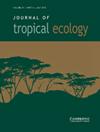凋落叶蛙的丰度随着牧草的演替而增加
IF 1
4区 环境科学与生态学
Q4 ECOLOGY
引用次数: 0
摘要
人为活动对森林的广泛砍伐和改造是生物多样性丧失的主要驱动因素。常见物种的减少尤其令人担忧,因为它们可能对生态系统产生巨大的连锁效应。在土地转换之前,次生林的再生可以通过将栖息地恢复到类似的条件来帮助扭转种群下降的趋势,但这些次生林对动物群的价值尚未得到很好的了解。我们比较了一种直接发育的陆生蛙(Craugastor stejnegerianus)在牧场、次生林和成熟林的河岸和高地生境的丰度。每样带平均丰度在高原牧场低于成熟森林。次生林的丰度与成熟林的丰度相似。我们表明,森林栖息地向牧场的转变对该物种的保护构成了威胁。然而,河岸缓冲带有助于减轻森林向牧场转化的负面影响,次生林的再生是恢复这一常见落叶物种丰富度的有效管理策略。本文章由计算机程序翻译,如有差异,请以英文原文为准。
Leaf-litter frog abundance increases during succession of regenerating pastures
The extensive clearing and modification of forests by anthropogenic activities is a major driver of biodiversity loss. Declines of common species are especially concerning because of the potentially large cascading effects they might have on ecosystems. Regrowth of secondary forests may help reverse population declines by restoring habitats to similar conditions prior to land conversion but the value of these secondary forests to fauna is not well understood. We compared the abundance of a direct-developing terrestrial frog, Craugastor stejnegerianus , in riparian and upland habitats of pasture, secondary forest, and mature forest sites. Mean abundance per transect was lower in upland pasture compared to mature forest. Secondary forest had similar abundance to mature forest regardless of age. We show that conversion of forest habitat to pasture represents a conservation threat to this species. However, riparian buffers help mitigate the negative effect of conversion of forest to pasture, and regrowth of secondary forest is an effective management strategy for restoring the abundance of this common leaf-litter species.
求助全文
通过发布文献求助,成功后即可免费获取论文全文。
去求助
来源期刊

Journal of Tropical Ecology
环境科学-生态学
CiteScore
2.10
自引率
0.00%
发文量
44
审稿时长
18-36 weeks
期刊介绍:
Journal of Tropical Ecology aims to address topics of general relevance and significance to tropical ecology. This includes sub-disciplines of ecology, such as conservation biology, evolutionary ecology, marine ecology, microbial ecology, molecular ecology, quantitative ecology, etc. Studies in the field of tropical medicine, specifically where it involves ecological surroundings (e.g., zoonotic or vector-borne disease ecology), are also suitable. We also welcome methods papers, provided that the techniques are well-described and are of broad general utility.
Please keep in mind that studies focused on specific geographic regions or on particular taxa will be better suited to more specialist journals. In order to help the editors make their decision, in your cover letter please address the specific hypothesis your study addresses, and how the results will interest the broad field of tropical ecology. While we will consider purely descriptive studies of outstanding general interest, the case for them should be made in the cover letter.
 求助内容:
求助内容: 应助结果提醒方式:
应助结果提醒方式:


